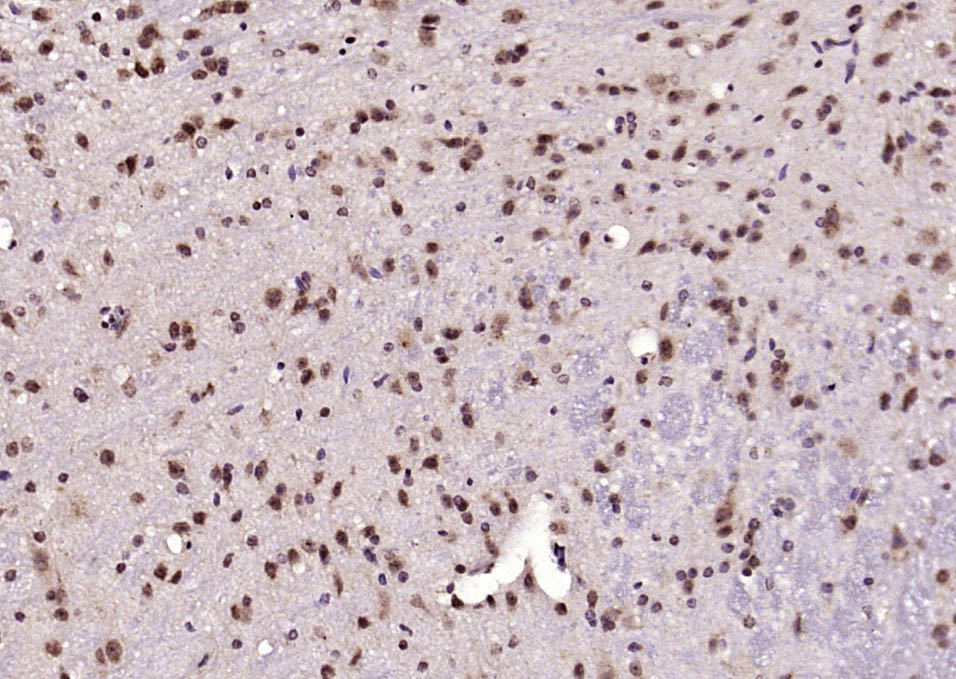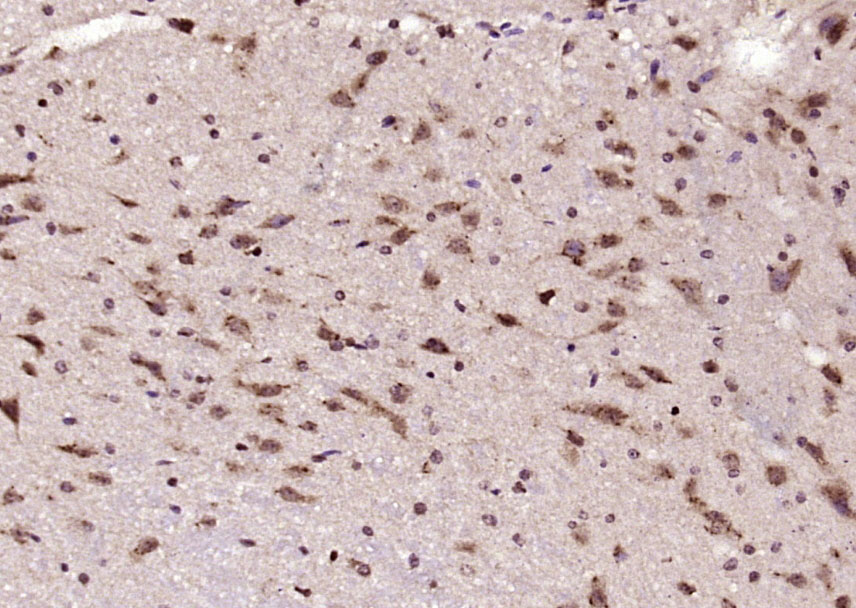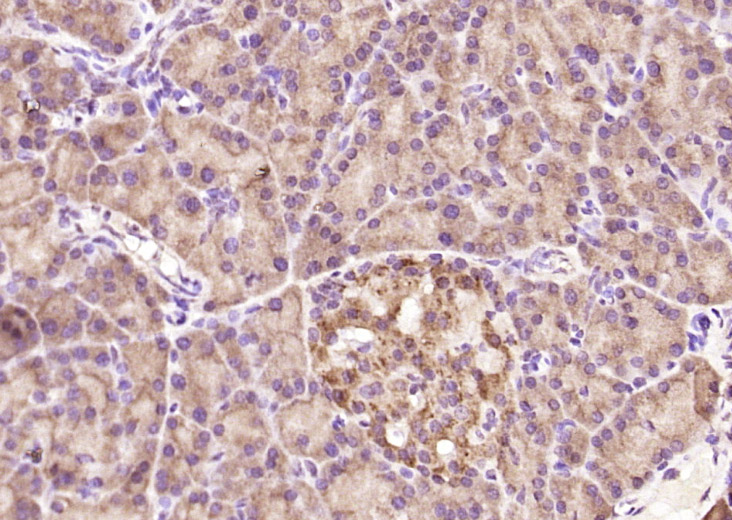
Rabbit Anti-hnRNP Q antibody
cytoplasmic RNA-interacting protein; dJ3J17.2; Glycine and tyrosine rich RNA binding protein; Glycine- and tyrosine-rich RNA-binding protein; GRY RBP; GRY-RBP; Heterogeneous nuclear ribonucleoprotein Q; hnRNP Q; HNRPQ 1; HNRPQ; HNRPQ_HUMAN; HNRPQ1; NS1 as
View History [Clear]
Details
Product Name hnRNP Q Chinese Name 异质核糖核蛋白Q抗体 Alias cytoplasmic RNA-interacting protein; dJ3J17.2; Glycine and tyrosine rich RNA binding protein; Glycine- and tyrosine-rich RNA-binding protein; GRY RBP; GRY-RBP; Heterogeneous nuclear ribonucleoprotein Q; hnRNP Q; HNRPQ 1; HNRPQ; HNRPQ_HUMAN; HNRPQ1; NS1 associated protein 1; NS1-associated protein 1; NSAP 1; NSAP1; pp68; RP1 3J17.2; Synaptotagmin binding cytoplasmic RNA interacting protein; Synaptotagmin-binding; SYNCRIP. Research Area Cell biology Binding protein Epigenetics Immunogen Species Rabbit Clonality Polyclonal React Species Mouse, Rat, (predicted: Human, Cow, Horse, ) Applications ELISA=1:5000-10000 IHC-P=1:100-500 IHC-F=1:100-500 ICC=1:100-500 IF=1:100-500 (Paraffin sections need antigen repair)
not yet tested in other applications.
optimal dilutions/concentrations should be determined by the end user.Theoretical molecular weight 69kDa Cellular localization The nucleus Form Liquid Concentration 1mg/ml immunogen KLH conjugated synthetic peptide derived from human hnRNP Q: 51-150/623 Lsotype IgG Purification affinity purified by Protein A Buffer Solution 0.01M TBS(pH7.4) with 1% BSA, 0.03% Proclin300 and 50% Glycerol. Storage Shipped at 4℃. Store at -20 °C for one year. Avoid repeated freeze/thaw cycles. Attention This product as supplied is intended for research use only, not for use in human, therapeutic or diagnostic applications. PubMed PubMed Product Detail This gene encodes a member of the cellular heterogeneous nuclear ribonucleoprotein (hnRNP) family. hnRNPs are RNA binding proteins that complex with heterogeneous nuclear RNA (hnRNA) and regulate alternative splicing, polyadenylation, and other aspects of mRNA metabolism and transport. The encoded protein plays a role in multiple aspects of mRNA maturation and is associated with several multiprotein complexes including the apoB RNA editing-complex and survival of motor neurons (SMN) complex. Alternatively spliced transcript variants encoding multiple isoforms have been observed for this gene, and a pseudogene of this gene is located on the short arm of chromosome 20. [provided by RefSeq, Dec 2011]
Function:
Heterogenous nuclear ribonucleoprotein (hnRNP) implicated in mRNA processing mechanisms. Component of the CRD-mediated complex that promotes MYC mRNA stability. Isoform 1, isoform 2 and isoform 3 are associated in vitro with pre-mRNA, splicing intermediates and mature mRNA protein complexes. Isoform 1 binds to apoB mRNA AU-rich sequences. Isoform 1 is part of the APOB mRNA editosome complex and may modulate the postranscriptional C to U RNA-editing of the APOB mRNA through either by binding to A1CF (APOBEC1 complementation factor), to APOBEC1 or to RNA itself. May be involved in translationally coupled mRNA turnover. Implicated with other RNA-binding proteins in the cytoplasmic deadenylation/translational and decay interplay of the FOS mRNA mediated by the major coding-region determinant of instability (mCRD) domain. Interacts in vitro preferentially with poly(A) and poly(U) RNA sequences. Isoform 3 may be involved in cytoplasmic vesicle-based mRNA transport through interaction with synaptotagmins.
Subcellular Location:
Nucleus > nucleoplasm. Expressed predominantly in the nucleoplasm and Cytoplasm. Microsome. Endoplasmic reticulum. Nucleus. The tyrosine phosphorylated form bound to RNA is found in microsomes (By similarity). Localized in cytoplasmic mRNP granules containing untranslated mRNAs.
Tissue Specificity:
Ubiquitously expressed. Detected in heart, brain, pancreas, placenta, spleen, lung, liver, skeletal muscle, kidney, thymus, prostate, uterus, small intestine, colon, peripheral blood and testis.
Post-translational modifications:
Phosphorylated on tyrosine. The membrane-bound form found in microsomes is phosphorylated in vitro by insulin receptor tyrosine kinase (INSR). Phosphorylation is inhibited upon binding to RNA, whereas the cytoplasmic form is poorly phosphorylated (By similarity). Phosphorylated upon DNA damage, probably by ATM or ATR.
Similarity:
Contains 3 RRM (RNA recognition motif) domains.
SWISS:
O60506
Gene ID:
10492
Database links:Entrez Gene: 10492 Human
Entrez Gene: 56403 Mouse
SwissProt: O60506 Human
SwissProt: Q7TMK9 Mouse
Unigene: 571177 Human
Unigene: 260545 Mouse
Unigene: 202606 Rat
Product Picture
References (0)
No References
Bought notes(bought amounts latest0)
No one bought this product
User Comment(Total0User Comment Num)
- No comment





 +86 571 56623320
+86 571 56623320
 +86 18668110335
+86 18668110335

